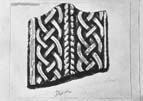Select a site alphabetically from the choices shown in the box below. Alternatively, browse sculptural examples using the Forward/Back buttons.
Chapters for this volume, along with copies of original in-text images, are available here.
Object type: Part of grave-cover(?) [1]
Measurements: Not recorded
Stone type: Not recorded
Plate numbers in printed volume: Ill. 353
Corpus volume reference: Vol 5 p. 257
(There may be more views or larger images available for this item. Click on the thumbnail image to view.)
A (top): The Ross manuscript drawing (Ill. 353) shows the decorated upper surface of what appears to be a section from the centre of a grave-cover of no great depth. The stone has plain borders along two opposed edges: the ends are irregularly broken. The decorated area is divided equally in two by a central rib of double-cabled form, and the two narrow fields are filled with four-strand plait.
Among the traditions of Lincolnshire grave-covers, that of sub-dividing the decorative field by a large cross and infilling the fields with runs of simple plait has its strongest analogies in the south of the county and the Barnack products of the Cambridge region (cf. Chapter V). The use of a cabled median ridge is nevertheless found distinctively in Lindsey in the 'Lindsey cover' variants, Broughton 1 and Cumberworth 1, in both cases as a single cabled ridge (Ills. 69, 151). A cabled rib is also found occasionally among the mid-Kesteven covers dividing the asymmetrical runs of interlace on the flanks, as at Lincoln St Mary-le-Wigford 2 (Ill. 271), as well as the ubiquitous rather flat double cables or chevrons dividing the panels (Fig. 9). A large cover at Peterborough Cathedral employs particularly elaborate double cabling to define and divide panels filled with interlace (Fox 1920–1, pl. III), while some of the earliest (i.e. later eleventh- or early twelfth-century) fonts in Lindsey, for example at Cabourne, Holton le Clay and Holton le Moor, deploy boldly moulded double cables. Taken together this may indicate a later rather than earlier date for this fragment.
This stone's decoration clearly provided the inspiration for the gable cross on St Mary's north transept, that dates from Atkinson's restorations.



